In this blog we have covered all possible seating arrangement questions asked in competitive exams. These seating arrangement question and tricks are useful for SSC CGL , IBPS PO , IBPS clerk , SBI PO , SBI clerk , Specialist officer , any government exam and any other competitive exams.
Table of content :
1) Linear arrangement questions concept and tricks
2) Circular seating arrangement concepts and tricks
Linear arrangements concepts and tricks
Linear seating arrangements types of question asked in all the government and placement papers. The question arises on arranging people on a row and asking questions out of it. There is no particular trick to solve these types of questions.
Yes, there is one important trick which can solve these types of questions i.e Reading and interpretation of questions properly.
Note – Our right is point’s right and our left is point’s left in linear arrangement question. So don’t get confused with left and right.
Let us jump into questions.
Question ) Six people – A,B,C,D,E & F are sitting in a row. A & F are sitting are adjacent to each other. C is two places to the right of E and neither of them sits in the extreme ends. There is one person sitting between A & B. Who is sitting to the immediate right of E.
Solution – Break the question in number of statements.Now we have 3 statements and we will one by one statement
Statement 1 – A & F are sitting are adjacent to each other. Below 5 arrangements are possible.

Statement 2 – C is two places to the right of E and neither of them sits in the extreme ends.
By this statement – C and E cannot be at the end position [1st and 6th] as neither of them sits in the extreme ends.
C is always two places right to E ,
if E at 2nd position then C should be at 4th
if E at 3rd position then C should be at 5th , So only 2 arrangement are possible.

Statement 3 – There is one person sitting between A & B.
If A at the 1st position , B should be at 3rd position and vice versa.
If A at 2nd position , B should be at 4th position and vice versa.
So we have total 4 arrangements.

Note – Statement which have least possibilities should be taken as base
We are most certainly with where E and C can sit with the least possibilities. So, we will try to fill up the gaps as taking step 2 as a base.
Let us keep E at the 3rd position and C at the 5th position and try to fill up the gaps.
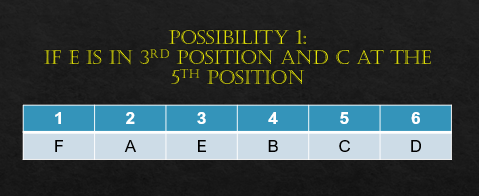
C is two places to the right of E.
There is one person between A and B.
All the conditions are satisfied.
Let us try to keep E at the 2nd position and B at the 4th position.
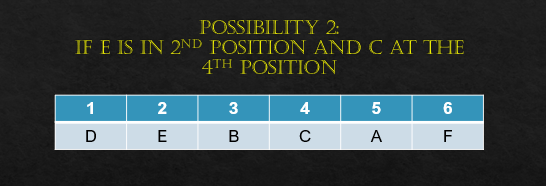
C is two places to the right of E.
There is one person between A and B.
All the conditions are satisfied.
If you can notice all the gaps can be filled with both the possibilities. We could call this a rare or unique question where both the possibilities satisfy all the conditions.
Lucky us, even if you complete any one of the possibilities you are in the position to answer the question. But in the exams, try to do both the possibilities so that you can be sure.
The question is: Who is to the immediate right of E?
If you check both the possibilities B is to the immediate right of E.
The answer: B
Let us solve another question:
Question ) A, B, C, D,&E are sitting in a bench. A is sitting next to B, C is sitting next to D, D is not sitting with E which is in left end of the bench, B is not adjacent to C, who is on the second position from right. In which position is A is sitting.
Solution: First, let us fix certain places for certain figures. Break the question in number of statements
So here we have 6 statement below
Statement 1 ) A is sitting next to B
Statement 2 ) C is sitting next to D
Statement 3 ) D is not sitting next to E
Statement 4 ) E is at the left end of bench
Statement 5 ) B is not adjacent to C
Statement 6 ) C is at the second most position from right.
From statement 4 and 6 – E should be at 1st and C should be at 4th position.
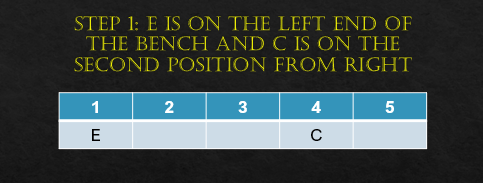
Statement 2 ) The question says A is sitting next to B. So, from the above picture it is very certainly said A and B must be seated in either in position 2 or 3.
Now, it is said B is not adjacent to C. That clearly implies that B has to sit on 2nd position and A has no other choice but to sit on the 3rd position. The 5th position is nothing but for D.

The question is to find out the position in which A is seated.
The answer: Middle
Key points to solve Seating arrangement question
1) Break the question in all possible statements.
2) Make the arrangement of all possible statements.
3) Now take the base step which has least possible arrangements.
4) Merge all the statement in this order by least possible arrangements
Circular Seating Arrangement concept and tricks
Circular arrangements describe the number of people sitting around a circular table and ask questions on it. It is all about understanding the concepts with ease. Here, we will portray the easiest way you can understand.
There are only two types on which questions can be asked.
1. Facing the center
2. Not facing the center
Understand the direction
For south facing or downward direction

For North facing or upward direction

The way to solve these type of questions is only by drawing a diagram
1) Facing the center
Understand the direction – facing towards the center
| points Direction | Direction |
| A is pointing downward or southward | Our right is point’s left Our left is point’s right. |
| B and C inside | Place yourself and decide the direction. |
| D is pointing upward or northward | Our right is point’s right Our left is point’s left. |
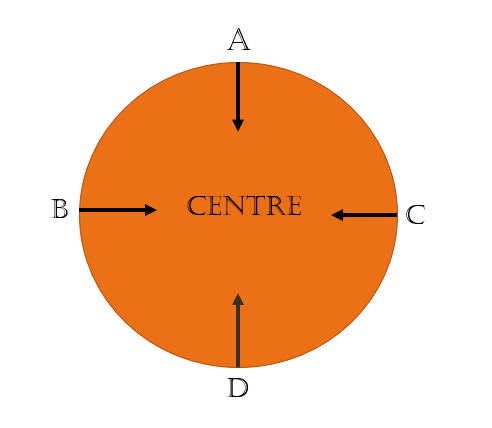
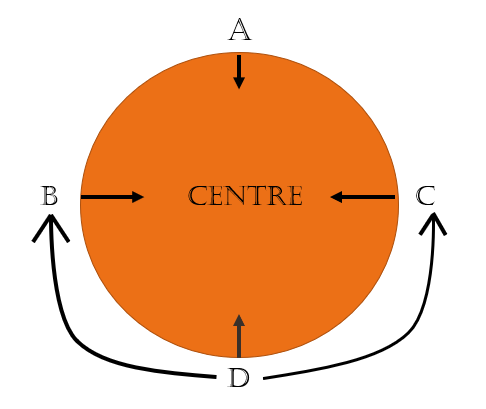
In facing the centre as per the above drawing
1. C is to the right and immediate right to D.
2. B is to the left and immediate left to D.
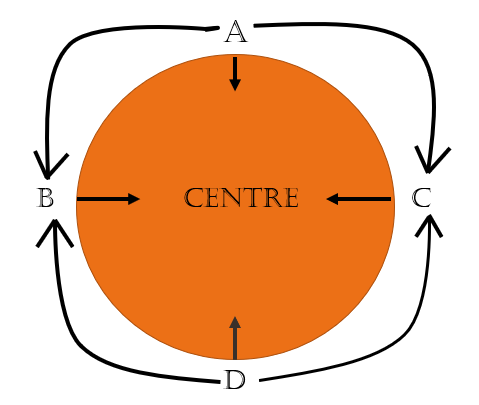
As per the above drawing:
1. C is to left and immediate left to A
2. B is to right and immediate right to A
These are thing to be remembered while solving these type of questions.
2) Not facing the center ( away from the center )
Understand the direction – facing away from center
| points Direction | Direction |
| A is pointing upward or northward | Our right is point’s right Our left is point’s left. |
| B and C outside | Place yourself and decide the direction. |
| D is pointing downward or southward | Our right is point’s left Our left is point’s right. |


In this above diagram:
1. C is to the left and to the immediate left to D.
2. B is to the right and to the immediate right to D.
3. B is to the left and to the immediate left to A.
4. C is to the right and to the immediate right to A.
Arrows are very important to indicate that either people are facing the center or not. It can also add to reference that people are facing the center or not. This trick helps you not to read the question multiple times.
Let us go through some of the examples.
Question ) In a buffet, 6 sweets are in a circular order of a table. B is opposite K. There is one sweet between L and B. G is to the immediate right of K. R is one of the sweets. Which sweet is two places to the left of G.
Solution: If there is no mention of facing or not facing of the circle then by default it is facing the circle.
Another important advantage of the circular arrangement is that you can place anywhere the first person you choose.
In this question, B is opposite to K, here, I can choose to keep B wherever I wish to.
Statement 1: B is opposite to K
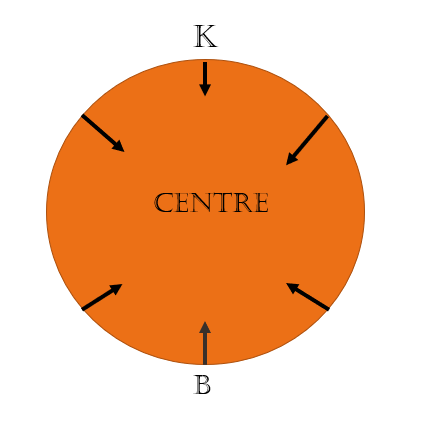
You can place B anywhere you want. But K should be opposite to B.
Statement 2: There is one sweet between L and B.
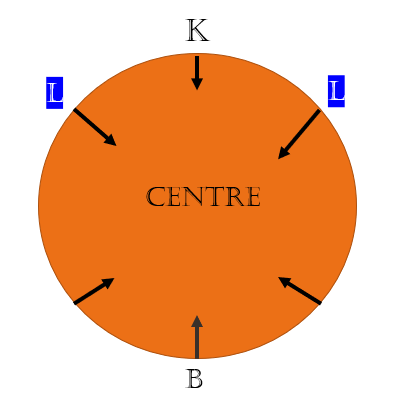
Statement 3: G is to the immediate right of K.
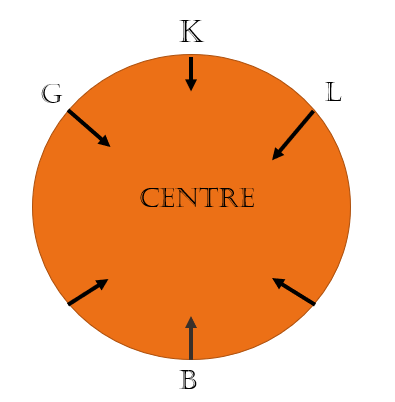
Then L has to be to the two-place right to B as shown above.
Statement 4: R is one of the sweets.
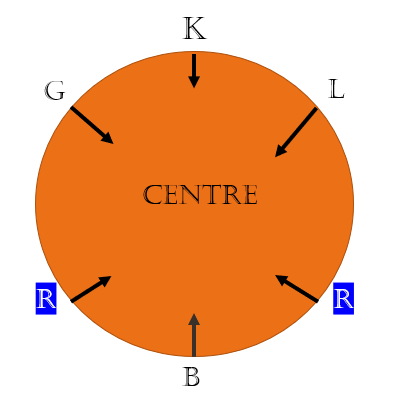
We have to find who is to two places to the left of G?
Answer: L
Let us see another example.
Question ) There are 6 people sitting around a circular table not facing the center. B is sitting three places to the right of A. C is sitting two places to the right of B. F is sitting three places to the left of C. D is sitting between A and F. E is also one of the persons. Who is sitting to the immediate left to A?
Solution:
Statement 1: B is sitting three places to the right of A.

Statement 2: C is sitting two places to the right of B.

Statement 3: F is sitting three places to left of D.
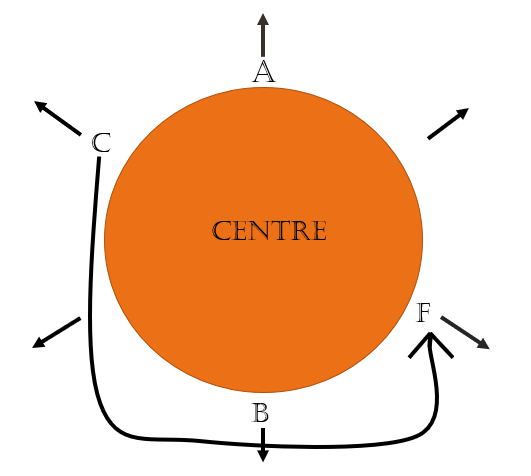
Statement 4 : D is sitting between A and F.
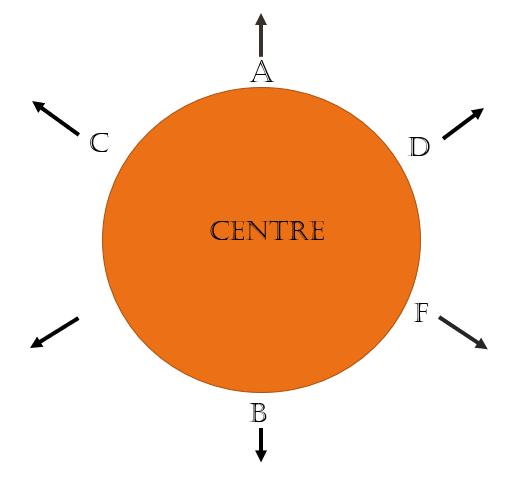
Statement 5 : E is also one of the persons.
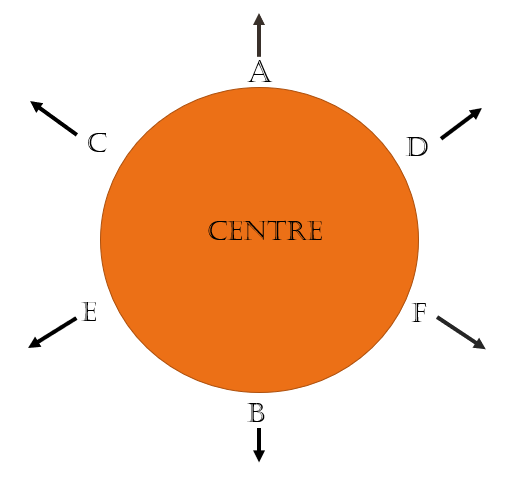
We have to find who is sitting to the immediate left to A.
Answer: C
Practice some Seating arrangements questions now.